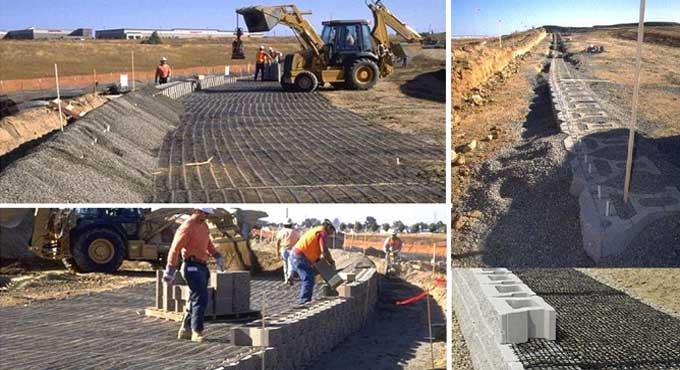NEWS | SOFTWARE | SHEET
How can you construct a Reinforced Retaining Wall using Geogrid?
What is Geogrid?
Geogrids are synthetic meshes that are made to be flexible and used for slope stabilization and earth retention. These grids come in a number of different materials, sizes, and strengths. They are normally packaged in rolls at the manufacturer and are constructed of high tensile strength polymers or woven polyester yarns.
Geogrid is a polymer-based geosynthetic material used in horizontal layers between wall courses and extending into the soil behind a wall.
The use of woven geotextiles and geogrids to provide internal drainage for Geosynthetic reinforced soil (GRS) walls with poorly draining marginal backfill improves the internal stability of buildings.
How do these Grids act?
The sandcastle test involves putting vertical force on two cylinders of the earth to observe how they perform. The initial cylinder consists only of compressed material. The second is made out of compacted material with mesh screens added to approximate the usage of geogrid reinforcement.
How can you construct a reinforced retaining wall using Geogrid?
Before continuing the process, make sure your primary layer of blocks is flattened and has been sufficiently covered on the front side of the wall. If done, you may proceed with the installation as follows:-
- Make your first drainage blanket section.
- Backfill to the height of the first block and at least the length of the geogrid you'll be installed behind the wall.
- Lay the geogrid at the top of the first block layer once the backfill has been suitably compacted and is the same height as the first block layer.
- The geogrid edge on the lower block should be set as far forward as feasible on the lower block without poking out of the face of the wall.
- You can simply roll out biaxial geogrid (also known as two-way geogrid) along the length of the wall if the roll width is large enough to satisfy the Geogrid Length equation.
- If you bought uniaxial geogrid (also known as one-way geogrid), cut it to the length you need and lay it out such that the heavy or stiff strands are perpendicular to the wall.
- You can now set the second block layer to pin the grid in place after you have covered the entire first block layer with geogrid of the correct length.
- With the grid anchored in place by the second row of blocks, begin carefully constructing your next drainage blanker, entirely wrapped in geotextile and backfilled on top of the grid, ensuring that the grid remains tight.
- Place the backfill in place and compact it.
- Do not forget to add the third row of blocks.
- Backfill to the height of block row 3 and compact it in place.
- Similar to Steps 1/2/3, place geogrid on the third row of blocks.
- Continue until you reach your desired wall height, compacting each backfill layer, constructing your drainage blanket, and installing geogrid on every second layer.
Few Advantages of using Geogrid Reinforcement:
A few advantages of using Geogrid in constructing reinforced retaining walls are as follows:-
- Land in-takes are reduced.
- Environmentally satisfying wall.
- Steeper and stronger walls.
- SuDS docile solutions.
- Less material consumption.
- Supply, design, installation, and maintenance from a single source.
- Don’t allow the planting to damage the formation.
To get more clear ideas, go through the following exclusive construction video tutorial.
Lecturer: Allan Block
Recommended Articles:
Reinforced Cement Concrete Retaining Wall (Cantilever Type) Information
Recommended Articles:
How to compute concrete volume for retaining wall


